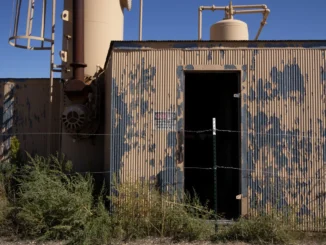
To those unfamiliar with weather modification, the mere suggestion that the practice takes place in Colorado might sound like some sort of fringe conspiracy theory. That being said, weather modification operations and research have been taking place in Colorado (and many places around the world) since at least the 1950s, with a state-run weather modification permitting program present since 1972.
The primary means of weather modification in Colorado is the act of ‘cloud seeding’ – “burning silver iodide through an ice nucleus generator that is carried up into the clouds to stimulate the precipitation process,” according to the state. In other words, the goal is to artificially improve a cloud’s ability to produce rain or snow.
Parties interested in ‘cloud seeding’ in Colorado must apply for a permit that is good for up to five years and can be renewable, with seven approved cloud seeding permits currently active in Colorado. Those behind the efforts mostly include ski areas and water conservation projects. After all, it’s easy to see how more snowpack might benefit resorts seeking to please snow-hungry guests or farming communities hoping to ensure a good crop yield.
Cloud seeding isn’t the only form of weather modification either. Per the Colorado Water Conservation Board, other means of modification include ground-based snowpack augmentation, airplane-based snowpack augmentation, airplane-based rain augmentation, hail suppression, and hail cannons. Each of these strategies can be used for a different result. For example, the hail cannon is a sort of shockwave generator that’s meant to disrupt the formation of hailstones, hopefully reducing the damage caused by a storm.
It’s also worth noting that weather modification operations in Colorado can be suspended under certain circumstances related to snowpack conditions and various weather warnings, among other factors. One reason for suspension is a high level of avalanche risk.
When it comes to cloud seeding, it’s a relatively common practice, but the verdict still seems to be out on how effective it really is.
A 2021 article from Scientific American looks at how cloud seeding is being used to help the West combat drought. This piece notes how difficult it is to determine whether or not cloud seeding efforts have any impact at all, mostly because it’s tricky to prove that a weather result would or would not have happened if the cloud seeding effort didn’t take place.
Statistical analysis tends to be used to determine effectiveness, with a study cited by Scientific American showing that seeded clouds can produce between five and 15 percent more snowfall. If this is true, the article notes that this is relatively cheap compared to other means of water conservation – a few dollars for an Olympic pool-sized share of water.
An organization called Colorado River District notes that a 15 percent increase in snowfall as it relates to their specific project alone could mean stream flows increase by 5 percent as snow melts, resulting in up to 80,000 acre-feet of water annually – enough to serve 160,000 households.
Meanwhile, in an article published by Yale, it’s noted that while cloud seeding works in a controlled setting, it’s unknown how much water the practice can actually produce in impacted areas. Cloud seeding as a solution to drought isn’t much of an answer either, as drought tends to mean fewer clouds that are candidates for seeding. There’s also the concern about the impact of pulling moisture out of a cloud when that moisture might be headed elsewhere, though some claim that this is a non-factor because so little moisture in a given cloud is actually impacted.
Whether weather modification will have a positive long-term impact or not seems to be a debatable topic, but there’s no doubt about it – weather modification does take place in Colorado, for better, for worse, or for not much result at all.
Here’s a current list of the 7 permitted weather modification projects, per the State of Colorado:
- Central Colorado Mountains River Basins (CCMRB) (Colorado River Water Conservation District, Front Range Water Council, Ski Areas of Breckenridge, Keystone, and Winter Park)
- There are three total areas permitted under the CCMRB
- Vail/Beaver Creek Program (Vail/Beaver Creek Ski Areas)
- Upper Gunnison River Basin Program (Gunnison County, Upper Gunnison River Water Conservation District)
- Grand Mesa (Water Enhancement Authority which is comprised of Collbran WCD, Fruitland Mesa WCD, Crawford WCD, Grand Mesa Pool)
- San Juan Mountains Program (Southwestern WCD, City of Durango, Animas La Plata WCD, Durango Mountain Resort, Dolores WCD, Pagosa Area Water and Sanitation District, San Juan WCD, San Juan Resource Conservation and Development Council)
- North Platte Basin Airborne Cloud Seeding Project (Jackson County Water Conservancy District)
- North Platte Basin Ground-Based Program (Jackson County Water Conservancy District)



